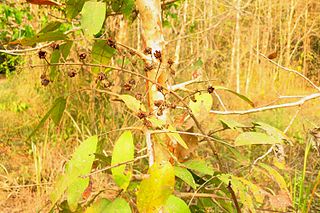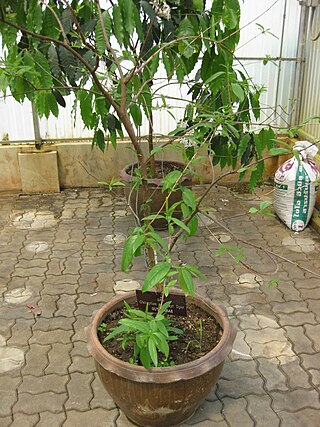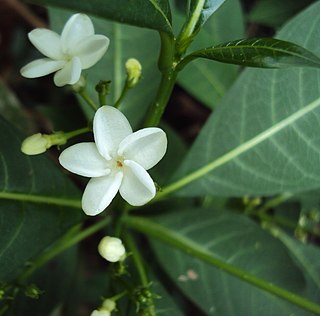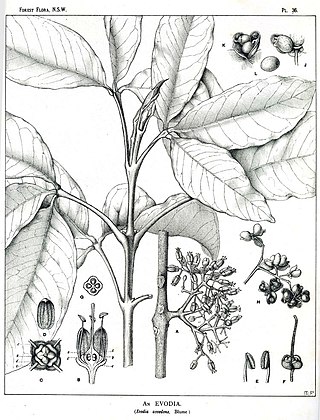
Cratoxylum arborescens is a plant in the family Hypericaceae. The specific epithet arborescens is from the Latin meaning "tree-like".

Cratoxylum cochinchinense is a plant now placed in the family Hypericaceae. The specific epithet cochinchinense is from the Latin meaning "of Cochinchina". In Vietnamese C. cochinchinense is usually called thành ngạch nam or lành ngạnh nam, other names include: hoàng ngưu mộc, hoàng ngưu trà and đỏ ngọn.

Cratoxylum maingayi is a flowering tree in the family Hypericaceae. The species is harvested for derum timber for limited local use.
Anisophyllea disticha is a plant of tropical Asia in the family Anisophylleaceae. The specific epithet disticha is from the Latin meaning "2-ranked", referring to the leaf arrangement.
Brackenridgea palustris is a tree in the family Ochnaceae. The specific epithet palustris is from the Latin meaning "swampy", referring to the species' habitat.

Euthemis is a genus of plant in the family Ochnaceae. The generic name is from the Greek meaning "good law", referring to the even thickness and symmetry of the leaves.

Campylospermum serratum is a plant in the family Ochnaceae. The specific epithet serratum is from the Latin meaning "with teeth", referring to the leaf margin. It is found in Tropical Asia, from Sulawesi, Indonesia to Hainan, Zhōngguó/China and over to southwestern India. Gomphia serrata was a previous common name for the species. The plant is used for its wood and its sap is used in folk medicine and in the past for teeth-blackening.
Kibara coriacea is a plant in the family Monimiaceae. The specific epithet coriacea is from the Latin meaning "leathery", referring to the leaves.

Rauvolfia verticillata, the common devil pepper, is a plant in the family Apocynaceae. The specific epithet verticillata means 'whorled' and refers to the plant's leaves.

Phaleria capitata is a species of flowering plant in the family Thymelaeaceae. It grows as a shrub or small tree up to 10 metres (30 ft) tall, with a stem diameter of up to 15 centimetres (6 in). Twigs are reddish brown. Inflorescences usually bear five flowers. The fruits are roundish, up to 1.5 cm (1 in) long. Habitat is forest from sea-level to 1,200 metres (3,900 ft) altitude. P. capitata grows naturally in Sri Lanka, Peninsular Malaysia, Sumatra, Borneo, Sulawesi, Maluku, the Philippines, New Guinea, the Caroline Islands and Tonga.
Alangium kurzii is a tree in the family Cornaceae. It is named for the German naturalist Wilhelm Sulpiz Kurz.
Combretocarpus is a monotypic genus of tree in the Anisophylleaceae family. The generic name combretocarpus is from the Greek, referring to the resemblance of its fruit to that of the genus Combretum. As of April 2014 The Plant List recognises the single species Combretocarpus rotundatus.
Deplanchea bancana is a tree in the family Bignoniaceae. It is named for Sumatra's Bangka Island.
Dacryodes costata is a tree in the family Burseraceae. The specific epithet costata is from the Latin meaning 'ribbed', likely referring to the prominent veins on the leaf underside.
Dacryodes laxa is a tree in the family Burseraceae. The specific epithet laxa is from the Latin meaning 'loose', referring to the inflorescence.

Euthemis leucocarpa is a plant in the family Ochnaceae. The specific epithet leucocarpa is from the Greek meaning 'white fruit'.
Schuurmansiella is a monotypic genus of plant in the family Ochnaceae. As of July 2024, Plants of the World Online recognises the single species Schuurmansiella angustifolia. The specific epithet angustifolia means "narrow leaf".
Anacolosa frutescens, also known as galo or galonut, is a plant in the family Olacaceae. The specific epithet frutescens is from the Latin frutex meaning 'shrub'. It produces edible fruits and nuts eaten in the Philippines.

Rhizophora stylosa, the spotted mangrove, red mangrove, small stilted mangrove or stilt-root mangrove, is a small to medium-sized evergreen tree in the family Rhizophoraceae. The specific epithet stylosa is from the Latin meaning 'stylus form', referring to the flower.

Melicope accedens is a plant in the family Rutaceae.









